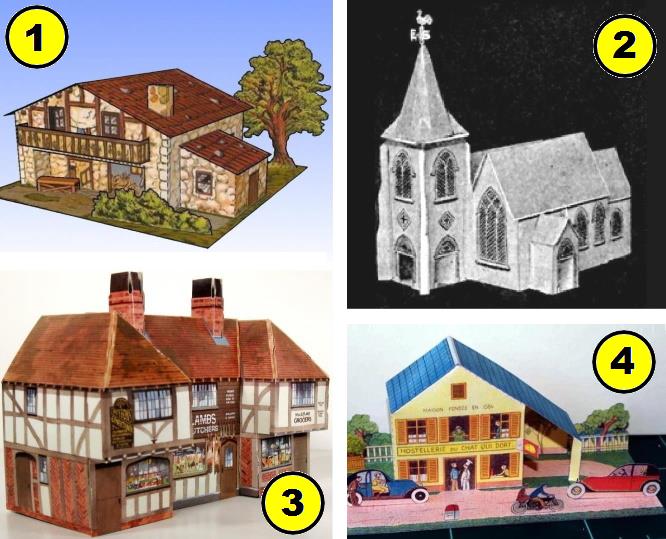My friend John Dunn, from the USA, assembled this beautiful vintage paper model of a fictional castle, Ravnerede (Raven’s Nest).
He kindly sent me some photos of his excellent work, and it is a pleasure to share them here on the blog.
John said: - "This fantasy castle, Ravnerede, was printed in a Danish weekly, Illusteret Familie-Journal, in the early 1930s.
The Great Depression was a world event and Europe was impoverished. Paper modeling was popular because even the poorest could afford it.
This print was preserved and shared by Esben Rasmussen. We are so lucky to have these images preserved and shared.
This is an easy build, and a good starter model. I always suggest a good base. Glue the printed base to some heavy cardboard or poster board. Press under weights for a day or two until totally dry and flat.
This build goes easily, but there is a slight correction on the little tower by the bridge. You will find it easily if you size and dry fit....
When you download the files, get the original file with the highest resolution. This was printed on card stock, 8.5 x 11, laser printer."
The Ravnerede paper model was originally published in Denmark and several other European countries by the magazine Illustreret Familie-Journal.
Thanks to the work of Esben Rasmussen, a paper modeling enthusiast dedicated to preserving and digitizing historical cutouts, this rare piece has been rescued and made available for sharing.
At the end of this post, you will find four links to download the complete model.
Illustreret Familie-Journal was a highly influential Danish magazine, published between the late 19th and early 20th centuries.
Founded in 1877 by Carl Aller, the magazine featured a variety of content, including serialized stories, illustrations, informative articles, and, often, cutouts and paper toys for its readers.
Due to its affordable price, the publication became extremely popular among middle-class and working-class families, establishing itself as a landmark in the Danish publishing industry and European popular culture of the time.
John Dunn is a longtime friend of this blog and has contributed numerous works to the Ephemeral Museum.
At the end of this post, right after the links to download the castle templates, I have also included some links to other incredible models that he has kindly given me the honor of publishing.
"Thank you, John, for another excellent work and for allowing me to share it here on the blog. Greetings from Brazil!" — Mauther
Meu amigo John Dunn, dos EUA, montou este belo modelo de papel antigo de um castelo fictício, o Ravnerede (Ninho do Corvo).
Ele gentilmente me enviou algumas fotos de seu excelente trabalho, e é um prazer compartilhá-las aqui no blog.
John comentou: - "Este castelo de fantasia, Ravnerede, foi publicado em um semanário dinamarquês, o Illustreret Familie-Journal, no início da década de 1930.
Naquela época, a Grande Depressão afetava o mundo inteiro, e a Europa estava empobrecida. A modelagem em papel era uma opção acessível, já que até os mais pobres podiam se dar ao luxo de montar esses modelos.
Esta impressão foi preservada e compartilhada por Esben Rasmussen, e temos muita sorte de contar com essas imagens digitalizadas e disponíveis para todos.
A montagem deste modelo é simples, sendo uma ótima opção para iniciantes. Sempre recomendo começar com uma boa base: cole a base impressa em um papelão grosso ou papel-cartão, pressionando-a sob pesos por um ou dois dias para que seque completamente e fique plana.
Embora seja uma construção fácil, há uma pequena correção na torre menor, próxima à ponte. Você a identificará facilmente ao ajustar as peças a seco antes de colar.
Para garantir a melhor qualidade, baixe o arquivo original na resolução mais alta disponível. O modelo foi impresso em papel-cartão, usando uma impressora a laser no formato 8,5 x 11 polegadas."
O modelo de papel do castelo Ravnerede foi originalmente publicado na Dinamarca e em diversos países da Europa pela revista Illustreret Familie-Journal.
Graças ao trabalho de Esben Rasmussen, um entusiasta da modelagem em papel dedicado à preservação e digitalização de recortáveis históricos, essa peça rara pôde ser resgatada e compartilhada.
No final deste post, você encontrará quatro links para baixar o modelo completo. A Illustreret Familie-Journal foi uma revista dinamarquesa de grande impacto, publicada entre o final do século XIX e o início do século XX.
Fundada em 1877 por Carl Aller, a revista apresentava um conteúdo variado, incluindo histórias em série, ilustrações, artigos informativos e, frequentemente, recortáveis e brinquedos de papel para seus leitores.
Graças ao seu preço acessível, a publicação tornou-se extremamente popular entre as famílias da classe média e trabalhadora, consolidando-se como um marco na indústria editorial dinamarquesa e na cultura popular europeia da época.
John Dunn é um amigo de longa data aqui do blog e já contribuiu com diversos trabalhos para o Ephemeral Museum.
No final deste post, logo após os links para baixar os templates do castelo, incluí também alguns links para outros modelos incríveis que ele gentilmente me deu a honra de publicar.
"Obrigado, John, por mais um excelente trabalho e por me permitir compartilhá-lo aqui no blog. Saudações do Brasil!" — Mauther
































